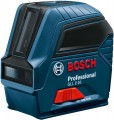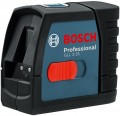Measurement range
The range at which the device remains fully operational without the use of additional receivers (see below); in other words, the radius of its action without auxiliary devices.
In some models, a range may be specified that shows the minimum (
3 cm,
5 cm) and maximum measurement ranges. But in most cases, only the maximum value is indicated.
The specific meaning of this parameter is determined by the type of instrument (see above). So, for optical levels, the measurement range is the greatest distance at which the operator can normally see the divisions of a standard leveling staff. For laser levels, this parameter determines the distance from the device to the surface on which the mark is projected, at which this projection will be easily visible to the naked eye; and in rangefinders we are talking about the greatest distance that can be measured. Typically, the measurement range is indicated for ideal conditions - in particular, in the absence of impurities in the air; in practice, it may be less due to dust, fog, or vice versa, bright sunlight "overlapping" the mark. At the same time, tools of the same type can be compared according to this characteristic.
Note that it is worth choosing a device according to the range of action, taking into account the features of the tasks that are planned to be solved with its help: after all, a large measurement range usually significa
...ntly affects the dimensions, weight, power consumption and price, but it is far from always required. For example, it hardly makes sense to look for a powerful laser level at 30-40 m if you need a device for finishing work in standard apartments.Auto power off
The time after which the device turns off by itself completely if the user does not perform any action.
See above for more information on auto power off; and his time has a double meaning. On the one hand, if this time is short, then the idle time of the device will be minimal, which helps to save energy. On the other hand, too frequent auto-shutdown (with subsequent switching on for work) is also undesirable — it increases the wear of components and reduces the resource, and it is not always convenient for the user. So manufacturers choose the time, taking into account the balance between these moments, as well as the general class and purpose of the device. So, in some rangefinders, this indicator does not even reach a minute, although in most such devices it is in the range from 3 to 8 minutes; and in some professional devices (primarily levels), the auto-off time can be 30 minutes or more (up to 3 hours).
Diode emission
The wavelength of the radiation emitted by the LED of the level or rangefinder; this parameter determines primarily the colour of the laser beam. The most widespread in modern models are LEDs with a wavelength of about 635 nm — at a relatively low cost, they provide bright red radiation, giving a well-visible projection. There are also green lasers, usually at 532 nm — the marks from them are even better visible, but such LEDs are quite expensive and rarely used. And radiation with a wave longer than 780 nm belongs to the infrared spectrum. Such a laser is invisible to the naked eye and is poorly suited for leveling, but it can be used in rangefinders — of course, with a viewfinder (see "Type" for more details).
IP protection rating
The level of protection against harmful influences (in the first place — the penetration of foreign objects) that the body of the level / rangefinder provides in accordance with the IP standard. This standard describes two separate characteristics — protection against solid objects and against water. They are designated respectively by the first and second digit after the IP index; the higher the number, the higher the degree of protection.
Considering that levels and rangefinders usually have to work on construction sites where there is a lot of dust, the minimum level of protection against solid objects for such tools is the fifth. It allows some dust to get inside, but in such a way that it does not affect the performance of the device. The maximum level of dust resistance is 6, which implies complete protection from solid particles.
The second characteristic, protection against moisture, in levels and rangefinders is usually indicated starting from level 4. Officially, it provides protection "against spray from any direction", in fact this means that it can be used in moderate rain with strong winds — a useful point in that if the tool is to be used outdoors. Level 5 allows operation during storms and downpours, a device of the sixth class can withstand being hit by a wave, the seventh — a short-term immersion under water up to 1 m, and the eighth — even a long stay under water. However, for a conventional construction tool, too high water resistance i...s usually not required.
Actually, the most popular option in modern construction tools is the IP54 class: it is quite enough even for work in bad weather, while such cases are relatively inexpensive. There are also more protected models, but less often.
It is also worth noting that a certain level of dust and water protection in itself is usually provided even in devices that do not have an IP marking. The absence of this index does not necessarily mean the absence of protection — it only says that the case has not been officially certified according to the IP standard. But if you need an additional guarantee of reliability, you should still pay attention to certified options.
Operating time
Operating time of the device on one battery charge.
It is worth considering that these figures are quite approximate, since the operating time is measured under certain standard conditions (usually continuous operation at nominal power). And since in practice conditions may differ markedly, the operating time may turn out to be noticeably shorter or longer than stated. In addition, if the device uses replaceable batteries (AAA, AA and the like), then autonomy will also depend on the quality of the specific batteries/accumulators. Nevertheless, based on the data specified in the characteristics, it is quite possible to evaluate the capabilities of specific models and compare them with each other: the difference in the declared operating time, as a rule, proportionally corresponds to the difference in practical autonomy under the same conditions.
We also note that the operating time is specified mainly for levels; in rangefinders another parameter is more often used - the number of measurements (see below).

